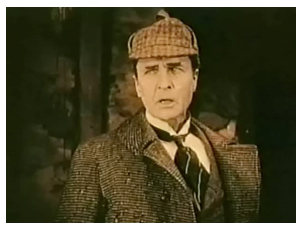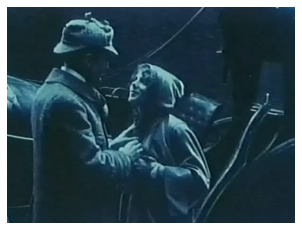

Essanay Film Manufacturing Company
Release Date: May 15, 1916
116 minutes
Directed by Arthur Berthelet
CAST: William Gillette (Sherlock Holmes), Marjorie Kay (Alice Faulkner), Ernest Maupain (Professor Moriarity), Edward Fielding (Dr. Watson), Mario Majeroni (James Larrabee), Grace Reals (Madge Larrabee), Burford Hampden (Billy), Stewart Robbins (Benjamin Forman), Hugh Thompson (Sir Edward Leighton), Ludwig Kreiss (Baronvon Stalburg), William Postance (Sidney Prince), Chester Beery (Craigin), Frank Hamilton (Tim Leary), Fred Malatesta ("Lightfoot" McTague), Leona Ball (Therese)
The record grooves are worn and crackly after more than 110 years of use. The tinkly piano accompaniment sounds the familiar crescendo phrases as Francesco Tamagno, opera composer Giuseppe Verdi's first Othello (rather, Otello in the Italian) steps up to the old recording horn. Then the great silver trumpet of a voice peals forth the clarion cry: "Exutalte!" The opera lover's heart leaps: here is where it all began. Here, still, is what we envision the majestic, tragic figure of Othello to be. There have been other great interpreters (Martinelli and Vickers among them) heard in more immediate sonics in the century since. But Tamagno was the progenitor, and in some ways he's never been bettered
You know where I'm going with this thought. Now, the parallel
isn't exact: the 1916 Essanay version of Sherlock Holmes,
presumed lost for more than nine decades until a single print
was found at la Cinémathèque française in
2014, hardly comes across as worn and crackly, thanks to the efforts
of film restorer Robert Byrne and his team. It looks astonishingly
good, in fact, the image sharp and stable, brushed with orange
and blue tints and buttressed by Neil Brand's fine score. The
first vignette we see is of Holmes in his laboratory, and we notice
 immediately the quiet underplaying
that comes from total confidence and identification -- as well
it might, for the Holmes before us, theater legend William Gillette,
had dramatized Arthur Conan Doyle's stories in 1899 and had trod
the boards as Holmes for seventeen years by that point. There's
nary a hint of weary resignation, however: there's simply being.
No "acting," no pickled trouper's demonstration of Here's
How I Do It. Just being.
immediately the quiet underplaying
that comes from total confidence and identification -- as well
it might, for the Holmes before us, theater legend William Gillette,
had dramatized Arthur Conan Doyle's stories in 1899 and had trod
the boards as Holmes for seventeen years by that point. There's
nary a hint of weary resignation, however: there's simply being.
No "acting," no pickled trouper's demonstration of Here's
How I Do It. Just being.
But let's back up a minute. Eager though you may be to Roll Film (I certainly was: how often is a Holy Grail of cinema discovered after a century's hiding?), I would counsel a bit of homework first. Among the many supplementary treasures of this set from Flicker Alley are two sound bites you should hear beforehand. (It's all right, Webmaster Tim: we'll get back to marble halls of silence anon.) First is a 1927 Fox Movietone News "interview" which captures about ten minutes of Conan Doyle at his estate. One can't help grinning, partly because many of us bought this newsreel on Super 8mm sound from Blackhawk Films some forty years ago, and nostalgia is a heady mixture; but one grins mainly because Conan Doyle is a total charmer: oh, we might wish he would hold forth a bit more on Holmes and rather less on spiritualism, but his brilliance and crinkly-eyed benevolence are most affectingly preserved.
Now go to the Main Menu page and, under Extras, click on another Fox Movietone News title, "'Sherlock Holmes' Turns Railroad Engineer." What we have here is a series of outtakes from a 1930 newsreel that shows Gillette squiring guests around his estate on a miniature locomotive. When he speaks to the camera about his love of trains, his voice immediately registers as the perfect complement to that square jaw and chiseled profile: crisp, sonorous, tempered by thousands of performances before the footlights. A few years later, when Gillette was in his eighties, a Harvard professor privately recorded his reciting several of Holmes's famous passages. You can find this recording on Youtube. Don't expect the Anglicized cadences of Basil Rathbone: there's clearly a Connecticut Yankee speaking here, and the voice is not that of a young man. But the authority is still commanding, the voice so appropriate to an Edwardian concept of Holmes. Conan Doyle himself seems to have thought so; an endearing story on Gillette's Wikipedia page, adapted from the Encyclopedia Sherlockiana, details the first encounter between author and actor:
 actor whipped out
a magnifying lens, examined Doyle's face closely, and declared
(precisely as Holmes himself might have done), "Unquestionably
an author!" Conan Doyle broke into a hearty laugh and the
partnership was sealed with the mirth and hospitality of a weekend
at [Conan Doyle's home] Undershaw. The two men became lifelong
friends.
actor whipped out
a magnifying lens, examined Doyle's face closely, and declared
(precisely as Holmes himself might have done), "Unquestionably
an author!" Conan Doyle broke into a hearty laugh and the
partnership was sealed with the mirth and hospitality of a weekend
at [Conan Doyle's home] Undershaw. The two men became lifelong
friends.We need the reverberation of Conan Doyle and Gillette's voices as we watch the film. Actually, if you lipread well and know Gillette's play, you'll recognize many of the lines falling from the actors' lips, often quite at variance with the intertitles. But keep drawing on the echo of those voices for contextualization: thought can add flesh to bone, and truth be admitted, this film needs those thoughts.
I hasten to add that Sherlock Holmes is worth every bit of the purchase price, particularly in Flicker Alley's superb blu ray incarnation and accompanied by a cornucopia of extras. But those of us who pan for gleaming nuggets from film's formative years have been spoiled by the best of Griffith and surviving contemporary fare such as Maurice Tourneur's The Wishing Ring, Harold M. Shaw's The Land Beyond the Sunset, and Lois Weber's Suspense; they're cinematic and fluid. Here, with Sherlock Holmes, one is often painfully aware of a century's passing.
Part of the problem is a stock device that even then was becoming antediluvian: intertitles that announce what is about is happen. These are ruinous to a mystery/thriller, even more so to a serial (as the film was reconfigured for a French reissue in 1919), slackening the narrative tension and pace. Just as ruinous is director Arthur Berthelet's way of changing camera perspective from long shot to medium: the players freeze, there's a s-l-o-w dissolve to medium, and the players return from rigor mortis to emoting. Whether this was a more-or-less commonplace technique of prewar filmmaking, I don't know; I can't recall having seen it in another film. But it too registers as an irritant, fixing the viewer in left-brain detachment.
Essanay, then on its last legs, played it safe, both financially and artistically, in adapting Sherlock Holmes to the screen: the sets look rather dimestore, and the camera (barring an occasional and welcome pan shot or traversal to outdoors) remains planted downstage center most of the time, proscenium ever on the periphery. Too, the supporting performances, pitched to the back wall of the third balcony, are steeped in Katy Bar the Door. The cast, a mixture of Essanay's stock players and actors from Gillette's touring company, range from all right (Edward Fielding's Dr. Watson is an intelligent and calm presence) to hilarious, as Grace Reals' Madge Larrabee strikes every barnstorming pose ever lampooned on The Carol Burnett Show.
We turn with hope to Holmes's nemesis, Professor Moriarty.
Holmes himself describes the Professor in The Final Solution:
"He is a man of good birth and excellent
education, endowed by nature with a phenomenal mathematical faculty."
An early intertitle in the film proudly announces that Ernest
Maupain, who plays Moriarty, is a former member of Sarah Bernhardt's
company. That's promising. What we get, however, makes one think
at points of Dr. Caligari, Josephine Crowell in Intolerence,
Donald Crisp in Broken Blossoms, and King Kong.
There's no criminal mastermind here, no brilliance that makes
Moriarty's confrontation with Holmes a case of diamond cut diamond.
There's only scowling and mugging to do any simian proud. We would
not be surprised if this Moriarty were to scarf down a banana
and swing from the chandeliers.
is a man of good birth and excellent
education, endowed by nature with a phenomenal mathematical faculty."
An early intertitle in the film proudly announces that Ernest
Maupain, who plays Moriarty, is a former member of Sarah Bernhardt's
company. That's promising. What we get, however, makes one think
at points of Dr. Caligari, Josephine Crowell in Intolerence,
Donald Crisp in Broken Blossoms, and King Kong.
There's no criminal mastermind here, no brilliance that makes
Moriarty's confrontation with Holmes a case of diamond cut diamond.
There's only scowling and mugging to do any simian proud. We would
not be surprised if this Moriarty were to scarf down a banana
and swing from the chandeliers.
But it's all right. Really, it's all right. We have William Gillette front and center, striding about and deliberating with calm, sometimes striking forth with pantherlike speed and precision, always radiating rightness in both senses of the word. Russsell Merritt, whose essay on Gillette's Holmes in the Flicker Alley booklet is one of the finest I've ever read, summarizes the radiant aura that Gillette casts in the film:
Can a film of Sherlock Holmes work if the leading
player is an anomaly? It can and does, ineffably, in the 1916
Essanay. One turns to scores of subsequent films and TV shows
for more artistic uniformity and technical flair as Conan Doyle's
most famous character continues to inspire new portrayals. But
to return to the infancy of cinema and sit before the first interpreter
of Sherlock Holmes is a moving experience indeed. Trapped amidst
so much that is quaint and primitive, Gillette's serene mastery
vaults the century with ease; Meerschaum pipe and deerstalker
hat in place, he brushes aside the cobwebs of antiquity. Conan
Doyle, that dear old spiritualist, would be proud of his friend's
own quietly won immortality.
Copyright 2016 by Dean Thompson. All rights reserved